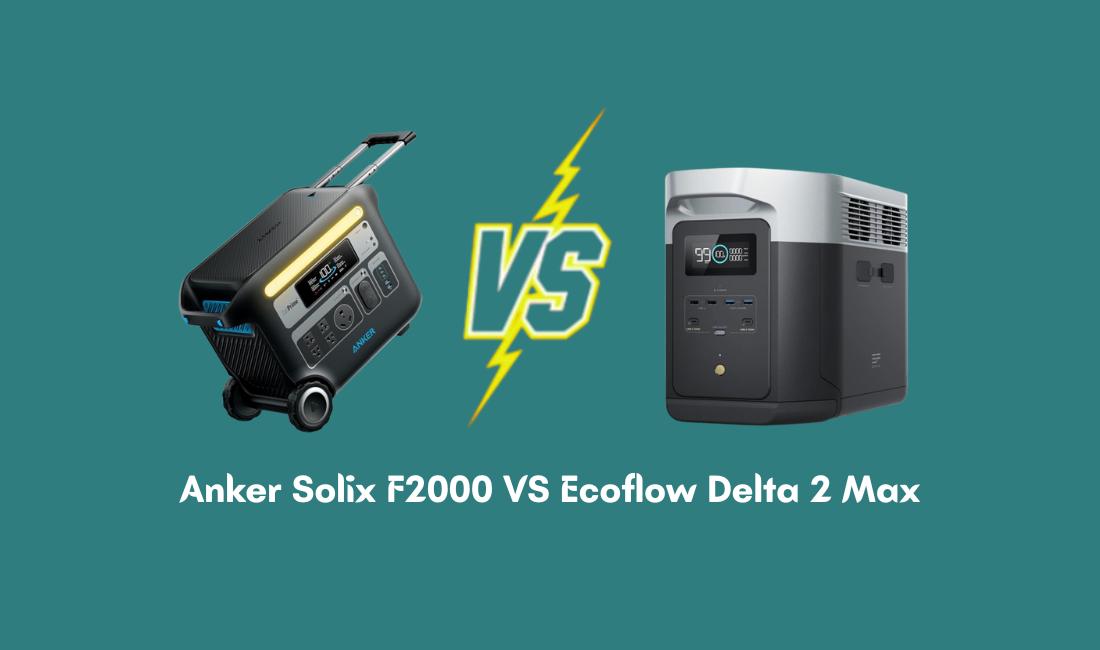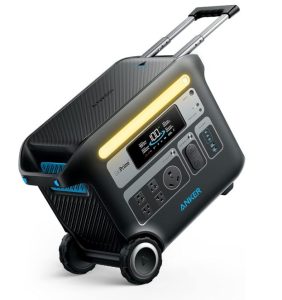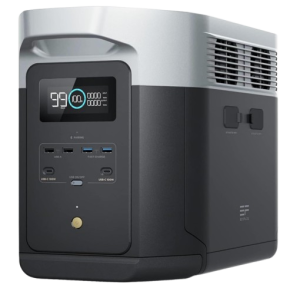
Anker Solix F2000 vs EcoFlow Delta 2 Max: Which Power Station Wins?

Power stations have become essential for modern homes, road trips, and off-grid adventures. The Anker Solix F2000 and EcoFlow Delta 2 Max stand as two of the most capable options, each built to deliver serious performance and reliability.
The Solix F2000 offers impressive capacity, durable construction, and rapid solar charging that supports both indoor and outdoor use. The Delta 2 Max focuses on smart connectivity, faster recharge times, and expandable battery options that suit tech-driven lifestyles.
Both deliver strong performance and long-lasting efficiency, but they cater to slightly different users—Anker prioritizes rugged dependability, while EcoFlow aims for intelligent energy management and flexibility.
Understanding their distinctions helps buyers decide which power station fits their energy goals, from home backup to adventure-ready freedom.
Each model represents a powerhouse in its own way, redefining what portable energy can achieve in today’s connected world. So Let’s see Anker Solix F2000 vs EcoFlow Delta 2 Max: Which Power Station Wins?
Anker SOLIX F2000 vs EcoFlow DELTA 2 Max: Full Comparison and Honest Review
Portable power stations have become more than just camping tools. They’re backup essentials for homes, travel partners for RV trips, and lifelines during unexpected blackouts.
Two of the most powerful and popular options today are the Anker SOLIX F2000 and the EcoFlow DELTA 2 Max.
Both promise high capacity, long life, and flexible charging options. Yet, each model has its own strengths that fit different kinds of users.
This guide explains every detail — from design to real-world performance — so you can decide which power station fits your lifestyle best.
Anker SOLIX F2000 (PowerHouse 767)
Product Details
The Anker SOLIX F2000, also known as the PowerHouse 767, is one of Anker’s strongest portable power stations. It’s designed for people who need stable and long-lasting energy for both home and outdoor use.
It features a 2048Wh battery capacity and can deliver up to 2400W of continuous power, with peak performance reaching 3600W using SurgePad technology.
Its power is enough to run almost any household appliance — refrigerators, washing machines, fans, or even power tools. Despite being a large unit, Anker made it manageable with built-in wheels and a sturdy telescopic handle.
Weighing around 67 pounds, it’s heavy but still portable for long trips, camping, or RV use. Anker also built this model using GaNPrime technology, improving power efficiency and heat management, meaning it stays cool even during intense use.
It supports both AC wall charging and solar input, making it a flexible option for users who like renewable energy sources.
Features
The SOLIX F2000 comes loaded with advanced tech that focuses on stability, speed, and safety.
-
2400W rated output, up to 3600W surge power for heavy loads.
-
2048Wh LiFePO4 battery, capable of over 3,000 charging cycles before dropping capacity.
-
HyperFlash charging, bringing the battery from 0% to 80% in just 1.4 hours.
-
12 total output ports, including 4 AC ports, 3 USB-C, 2 USB-A, 2 car sockets, and an RV plug.
-
Retractable LED light bar for night use.
-
Digital display screen that shows input, output, and battery status.
-
Temperature management system for battery protection.
-
Expandable with solar panels, compatible with Anker 100W and 400W models.
It also supports pass-through charging — meaning you can charge the power station while it’s powering other devices. That’s handy for keeping everything running smoothly during long outdoor stays or emergencies.
What is the Good?
The Anker SOLIX F2000’s strengths lie in its raw performance and durability.
-
Extremely high output handles even large home devices.
-
Fast charging cuts waiting time to less than 2 hours.
-
Long-lasting LiFePO4 battery means it stays reliable for over 10 years.
-
Multiple ports let you connect almost every kind of gadget or appliance.
-
Easy mobility with strong handle and large wheels.
-
Solid build quality feels premium and rugged.
-
Excellent warranty—a full 5 years, which builds user trust.
This model fits perfectly for serious users who need consistent energy during long power outages or outdoor work sessions.
What is the Bad?
No power station is flawless, and the SOLIX F2000 has a few limitations.
-
Heavy weight makes it hard to lift or move upstairs.
-
Solar panel and transfer kit cost extra.
-
Charging fan noise is noticeable during heavy load or fast charging.
-
No app control, unlike some modern rivals.
Still, most of these issues are small compared to the overall performance it offers.
Overall Opinion
The Anker SOLIX F2000 is built for people who need serious power and dependability. It works beautifully for home backup use, camping with multiple devices, or powering tools and appliances in remote areas.
It’s tough, fast, and reliable. The only downside is the weight, but the power capacity more than makes up for that. For users who want strength, stability, and years of use without worrying about battery life — this model stands tall.
EcoFlow DELTA 2 Max
Product Details
The EcoFlow DELTA 2 Max takes a modern approach to portable power. It offers 2048Wh of capacity, similar to the Anker, but focuses more on fast charging, smart control, and expandability. It can power up to 2400W continuously, with a surge limit of 3400W using its X-Boost feature.
The unit weighs about 50 pounds, making it 17 pounds lighter than the Anker SOLIX F2000. That weight difference gives it a real advantage for users who move their power station often — campers, overlanders, or small homeowners who need flexible backup power.
The best part? You can expand its capacity up to 6kWh by connecting extra EcoFlow batteries. That makes it great for users who want to start small but plan to grow their setup over time.
Features
The EcoFlow DELTA 2 Max includes many practical features that make power use simple and flexible:
-
2400W power output (up to 3400W with X-Boost).
-
2048Wh LiFePO4 battery that lasts over 3,000 cycles.
-
Extremely fast charging—80% in just 43 minutes with AC power.
-
15 total output ports, including 6 AC outlets, 4 USB-C, 2 USB-A, and a car socket.
-
Expandable up to 6kWh using extra batteries.
-
Quiet operation—as low as 30dB, ideal for nighttime use.
-
Built-in Wi-Fi and Bluetooth for smart app control.
-
Compatible with solar charging up to 1000W input.
-
Lightweight yet sturdy build, using reinforced ABS casing.
Its EcoFlow app gives you real-time monitoring, charge control, and firmware updates. This kind of smart connectivity gives it an edge for users who want an easy, tech-driven experience.
What is the Good?
The EcoFlow DELTA 2 Max stands out for speed, design, and flexibility.
-
Ultra-fast charging speed saves a lot of waiting time.
-
Lighter and smaller, easier to carry.
-
App control gives more control and data tracking.
-
Quiet operation, good for indoor use or sleep hours.
-
Expandable capacity, ideal for future upgrades.
-
Runs almost any home appliance, including microwaves, fridges, and laptops.
For users who like a smart and connected setup, it’s a well-rounded power station.
What is the Bad?
Some areas could be better.
-
Expansion batteries are expensive, adding to the total cost.
-
Plastic shell feels less durable compared to Anker’s robust body.
-
Add-ons like solar panels increase the investment quickly.
-
Warranty is decent, but not longer than competitors.
Still, the pros far outweigh the cons for most users, especially those who value portability and advanced control.
Overall Opinion
The EcoFlow DELTA 2 Max gives a balance of performance, intelligence, and portability. It’s perfect for everyday users who want something modern and fast.
It fits camping setups, small households, and even work-from-anywhere situations. Its flexibility to expand and its quick recharge speed make it future-ready and reliable for years.
Design and Build Quality
Anker’s SOLIX F2000 looks like a serious machine — heavy, bold, and built to survive rough conditions. It has an industrial design with a strong frame and wide handles.
The retractable handle and large wheels make it easy to move across the ground, even though it’s heavier. It feels ready for construction sites, RVs, or long-term home backup use.
The EcoFlow DELTA 2 Max, in contrast, has a sleeker and more modern look. It’s smaller, lighter, and easier to lift. The clean design makes it better for indoor environments, offices, or small apartments.
Both have digital screens showing input, output, and battery life, but EcoFlow’s screen and app integration feel more futuristic.
Performance in Real-Life Use
In real use, both perform impressively. The Anker SOLIX F2000 can run a refrigerator, a TV, a fan, and a laptop all at once without trouble. It keeps power stable even when handling large loads like coffee makers or microwaves.
For outdoor use, the built-in light and durable body help during camping or emergencies. The EcoFlow DELTA 2 Max shines in versatility.
Its charging speed is noticeably faster — you can charge it during breakfast and use it all day. The quiet operation makes it comfortable indoors. It’s also better for travel or quick setups since it’s easier to lift and store.
Detailed Comparison Of Anker SOLIX F2000 VS EcoFlow DELTA 2 Max
Both units share similar capacity and wattage, but they appeal to different kinds of users.
-
Battery and Lifespan: Both use LiFePO4 batteries with 3000+ cycles.
-
Charging Speed: EcoFlow wins with 43-minute fast charging, while Anker takes 1.4 hours.
-
Portability: EcoFlow is lighter at 50 pounds; Anker is heavier but has wheels.
-
Connectivity: EcoFlow offers app control, while Anker relies on manual display.
-
Durability: Anker’s frame feels more rugged and long-lasting.
-
Noise: EcoFlow runs quieter at 30dB.
-
Expandability: EcoFlow allows battery expansion up to 6kWh; Anker does not.
So, both are powerhouses — one prioritizes toughness, the other speed and smart use.
Which One Should You Buy?
If you need a heavy-duty power station that feels like a real generator replacement, go for the Anker SOLIX F2000. It’s built for long-term use, strong performance, and dependability.
If you want a smarter, lighter, and more flexible solution, pick the EcoFlow DELTA 2 Max. It fits users who prefer speed, silence, and smart app features.
Both are excellent — it just depends on your priorities: strength or convenience.
FAQs
Q1: Can both charge laptops and large home devices?
Yes, both handle laptops, TVs, fans, and even refrigerators easily.
Q2: Which one lasts longer per charge?
Both have similar battery capacity, but power use depends on what you plug in.
Q3: Do they both support solar charging?
Yes, both are solar-compatible, but solar panels are sold separately.
Q4: Which one is easier to carry?
EcoFlow is easier to lift, while Anker rolls on wheels.
Q5: Can I use them during power outages?
Yes, both make great home backup stations for blackouts.
Conclusion
The Anker SOLIX F2000 and EcoFlow DELTA 2 Max are two of the best portable power stations available today. Each brings its own kind of strength to the table.
The Anker SOLIX F2000 is for those who need reliability, durability, and long-term power. The EcoFlow DELTA 2 Max fits users who want speed, light weight, and modern smart control.
Both can easily handle home emergencies, camping adventures, and outdoor work. In the end, you can’t go wrong — it’s about what kind of user you are: rugged and practical or fast and connected.


